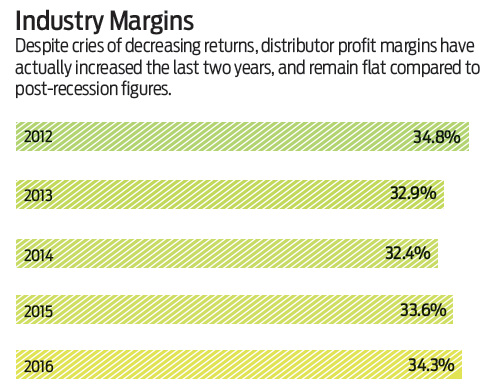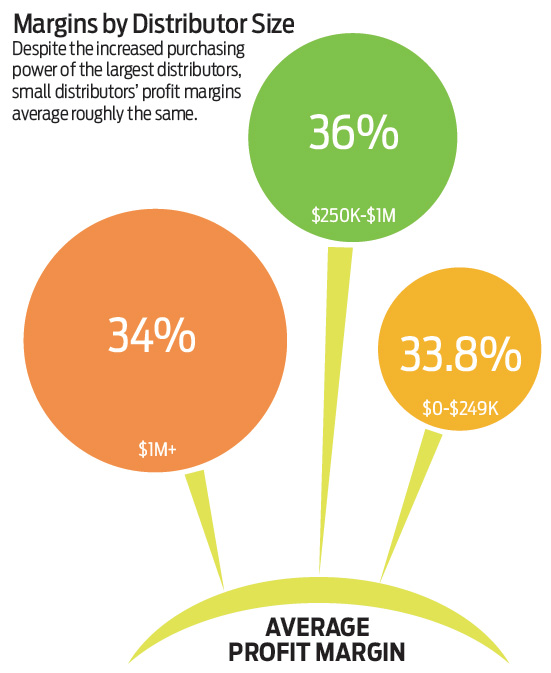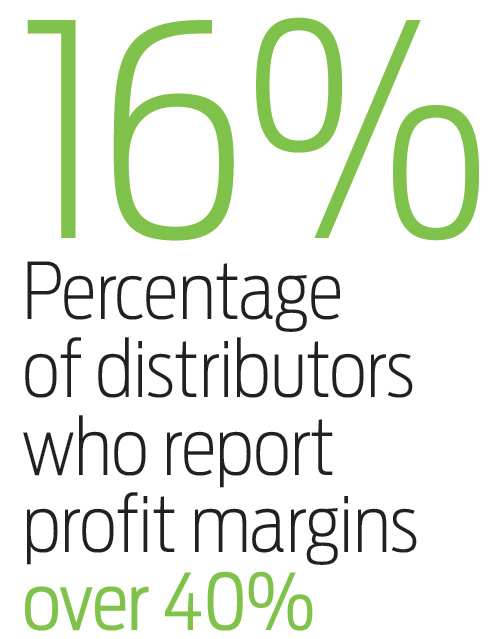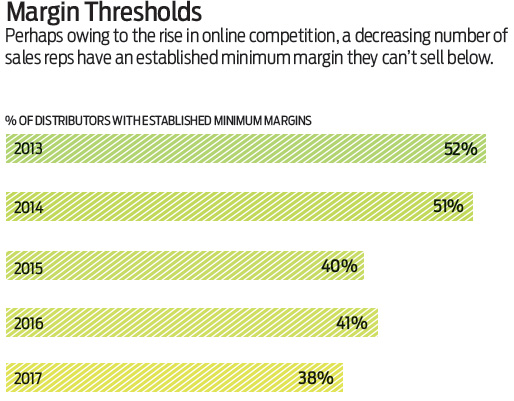Strategy January 29, 2018
6 Ways to Boost Margins
Margin pressure doesn’t have to be an inevitable force. Employ these essential strategies to stem the tide and goose your profitability.
Margin pressure is an insidious killer of profitability. For years, distributors have cited any number of reasons – from online competitors to penny-counting buyers – for their diminishing returns.
Matt O’Malley, senior account executive at Bob Lilly Promotions (asi/254138), believes the power is within distributors to raise their margins – they just have to challenge themselves to be bolder.
“I think a lot of people are scared to go after higher margins,” says O’Malley, whose company enjoys margins north of 40%. He believes “fear creeps in” for some distributors, and that by pursuing stronger, healthier margins, they risk losing that client’s business to a competitor.

The impulse is well-chronicled: give in on price to win customers. But that race to the bottom only hurts distributors in the long run. “When we continuously get beat up on price and margins,” says Jessica Ibsen, director of customer delight at Fully Promoted (asi/384000) in Mandeville, LA, “it cheapens the relationship and makes our industry more about commodities than building strong relationships and establishing value in the additional services we provide.”
The problem can be exacerbated for smaller distributors as larger distributors thrive (or at least outpace the rest in revenue growth) and big names like Walmart and Amazon dip their toe into the water. “With large companies getting into our industry, we need to keep the focus on those fringe benefits,” Ibsen adds, “because when we become a simple swag peddler, we have a very hard time competing with the big-box vendors who have more leverage and buying power than the standard industry distributor.”
Zachary Tyler sees the industry concern of lower profit margins, but says they shouldn’t be pinned on online, big-box competitors. Rather, he has issue with small, part-time distributors who don’t add value to the industry. “I don’t know that it’s mistakes distributors are making, per se; I think it’s a mistake that the industry has made in permitting too much competition in a kind of un-vetted way,” says Tyler, CEO of
Creative Marketing Concepts (asi/170631). Too much competition and industry-wide commoditization, he says, is “to the detriment of everybody except one or two parties.” Regardless of the source of margin pressure, the perception of it is very real (even if margins have actually increased the last two years – see sidebar on page 74). Distributors are wringing their hands and searching for reprieve.
The good news? Reaching high margins doesn’t necessitate a radical shift in your business model. With calculated planning and a reinforcement of the fundamentals, there are a number of effective methods to reach your profit goals. Here are six simple ways to raise your margins.
1. Establish Relationships
Chris Wallace, owner of Performance Print Services (asi/293664) in Durham, NC, says healthy margins begin with healthy relationships. That starts with the basics: responding to inquiries and concerns right away, and taking time to listen to the client in order to understand exactly what they need.
“My best strategy for maintaining good margins has been to establish a good relationship built on trust and exceptional customer service with my clients,” he says.
Case in point: In 2013, Wallace began printing small jobs for a technology company’s direct mail campaign. One year later, that company wanted to include promotional items with the print services, but decided to go with a lower-cost alternative instead of sticking with Wallace for those needs.

Rather than try to meet the competitor’s price at the expense of his margins, Wallace waited for the client to realize that going with the cheap alternative was a mistake. “They confessed that the cost savings did not make up for the lack of customer service,” he says. “Even though I still provide cost estimates, my client has since never questioned the cost and has always proceeded with the orders.”
That technology company has placed multiple promotional-product orders with Performance Print Services and continues to be thankful for the customer service it provides. “I stand by the philosophy that customers want a vendor they can trust with their work,” Wallace says, “and they are happy to pay more for that security once the relationship is established.”
2. Extend One-Time Discounts
To be clear, you can drop your margins to win a new customer’s order – as long as it’s known that it is, indeed, a one-time thing. “When courting new clients, I may need to go with a lower margin to compete with others,” says Wallace. “However, this isn’t a practice that I typically need to maintain as I continue to work with these customers.”
Adds Ibsen: “I think shaving margins has a time and place when trying to establish a new client relationship. Earning a client’s trust takes time and proven delivery, and often just to get that foot in the door you need to be better, or better priced, than their current provider.”
Building trust and raising service expectations can lead to healthy margins after an initial first-time hit. A prudent method is to present it as a special discount or circumstance to condition the customer not to expect it in the future. “When we do shave margins,” Ibsen says, “we call it a new-client discount or quote using a discount for pre-payment vs. term payments to give the client a better price. We give them the impression that their discount price should not be a regularly expected occurrence.”
At a recent open-house event, Ibsen gave out Willy Wonka bars that included a 10% off coupon and a “golden ticket” for a free piece of embroidery with a free digitized file – a pair of additional services that Fully Promoted provides. Doing so helped Ibsen earn some new business and show off her company’s additional services, while making it clear that this was a one-time offer.
“We do usually market it as a new-client or an introductory offer, or it can be a seasonal special, and in that case we’ll take the original price on their quote and show the markdown so they can see how much they’re saving,” she says. “It’s more (to show them) this is what they would be paying normally vs. what they’re getting offered now.”
3. Meet Clients Halfway
Once trust is in place, O’Malley says distributors can begin to look into slowly increasing prices to get their margins where they need to be, all while maintaining a strong relationship with the client.
“Rarely will I tell a customer I’ve got to raise my price just because the margins aren’t high enough. That would be kind of dangerous. But I have raised my prices on clients before,” says O’Malley.
Honesty can work. At the end of each calendar year, O’Malley has conversations with his clients about necessary price increases for next year – but he approaches those conversations in a way that actually builds client trust.
“If I’ve been selling a pen for a dollar, I can say, ‘Hey, this pen’s now gone up to $1.25, but I’m going to go to $1.12 and meet you halfway,’” he says. “Yes, I might go from a 44% margin to a 42%, but I can live with that in giving some goodwill to the client and making them feel good about what they’re doing.”
O’Malley warns about “getting greedy” when raising margins because it can result in disaster if the distributor gets caught. However, “once that trust is built, you don’t abuse it, but you can start inching up your margins over time,” he says, “and get to a point where you’re averaging a little more than you might have when you started.”
4. Promote Your Other Services
Ibsen says Fully Promoted’s services have often led to additional orders with margins north of 40%. “Our company deals with margin pressure by focusing more on the service side of our business,” she says. “We have advantages such as on-staff graphic design and decorating that give us an edge over some of the larger companies that don’t provide such personal service.”
Fully Promoted provides low-cost logo creation, raster-to-vector redrawing and quick-turn virtual proof creation, along with apparel personalization, including in-house embroidery and heat transfer. “This can be a huge asset for companies looking to get uniforms done in a short amount of time,” Ibsen says.
Expanding beyond promotional products works in two ways when it comes to raising margins: One, it allows distributors to offer services that naturally earn higher margins. And two, by offering a full suite of services (akin to a marketing agency), companies like Fully Promoted can even save customers money by eliminating the mark-up from suppliers that distributors pass on. “We can quote lower prices,” says Ibsen, “yet still make higher margins as a result.”

With those offerings, getting a customer in the door can easily lead to robust returns down the line. When a prospective medical client was looking to have its logo embroidered on a handful of shirts, Fully Promoted took on the order. Even though it was a small job, Ibsen saw the opportunity to introduce the client to Fully Promoted’s other services. “As a result of that, she found out that we do promotional items. She thought all we did was embroidering,” Ibsen says. “That simple start has led to about three different orders, each one being about $3,500 at a 45% margin, just because we showed her that courtesy and acquiesced on the initial order.”
Bottom line: If you have additional services to offer, play them up. By doing so, small orders can lead to big profit margins.
5. Ask Suppliers for Help
When trying to boost margins, always remember: There’s nothing wrong with asking your supplier partners for a discount of your own.
“I reach out to my favorite suppliers directly and talk to my reps, and ask for better pricing than a catalog list,” says Aaron Kist, senior account executive at American Solutions for Business (asi/120075). “In turn, I’m loyal to those suppliers who work with me. We would like the same from our own customers.”
But just as a strong distributor-client relationship is vital to healthy margins, so is a firm relationship between distributor and supplier. Kist says it’s a good idea to have that in place before asking for a price break.
“Building relationships with suppliers can help tremendously … but you have to ask to receive,” he says. “If you’re in a bid situation or just have a good opportunity for repeat orders on a product, it’s worth picking up the phone or emailing the supplier for help on product pricing.”
Ibsen says she has asked for discounts from her supplier partners, but only in certain situations. “I try not to make my relationships all about what kind of breaks can they give me this time,” she says, “but if we’re trying to price-match a competitor for a client, then occasionally we’ll try to ask them to match or meet, or beat that price.” She adds that distributors should work those vendor relationships where they receive next- or end-quantity pricing as well as use free spec samples when offered. “They give you a way to give your client a discount without compromising your margins,” she says.
6. Don’t Rush to Fire Customers
Unprofitable clients typically don’t merit the time and labor spent on them. Some cause too much aggravation and hurt productivity and morale. Others beat up reps on price, looking for every single little cost advantage. And some simply don’t order enough. Tyler of Creative Marketing Concepts sees too many part-time distributors hauling in small orders that eat up supplier attention and drive down margins. “There has to be a certain recognition that a $300 order to a distributor is as unprofitable as a $180 order is to a supplier,” he says. “Honestly, what good customer can’t afford a $600 order?”
Often, it makes sense to fire a customer who is harming your margins and isn’t worth your time. But instead of sending unprofitable clients packing, O’Malley recommends first considering a switch to a different product that will help raise your margins.
Take a phone charger, for example. O’Malley might try to encourage a client to buy a higher-priced charger by pitching its benefits, including explaining to the client that it has a higher safety rating. “I can switch them to a supplier that tests their chargers properly and just give them a little bit of security knowing they’re getting a good product,” he says. “That’s one way of doing it: Just pushing them to a different product that’s like what they’re asking for.”
O’Malley says distributors should always give clients options – especially those who aren’t as profitable as you’d like them to be. “Give them a good-better-best option. Clients are gravitating to the better or best,” he says. “You can give them the cheap option at a low margin, or you can offer a few others at higher margins because the product is better.”
Margin Math




Shane Dale is a contributing writer for Advantages.
